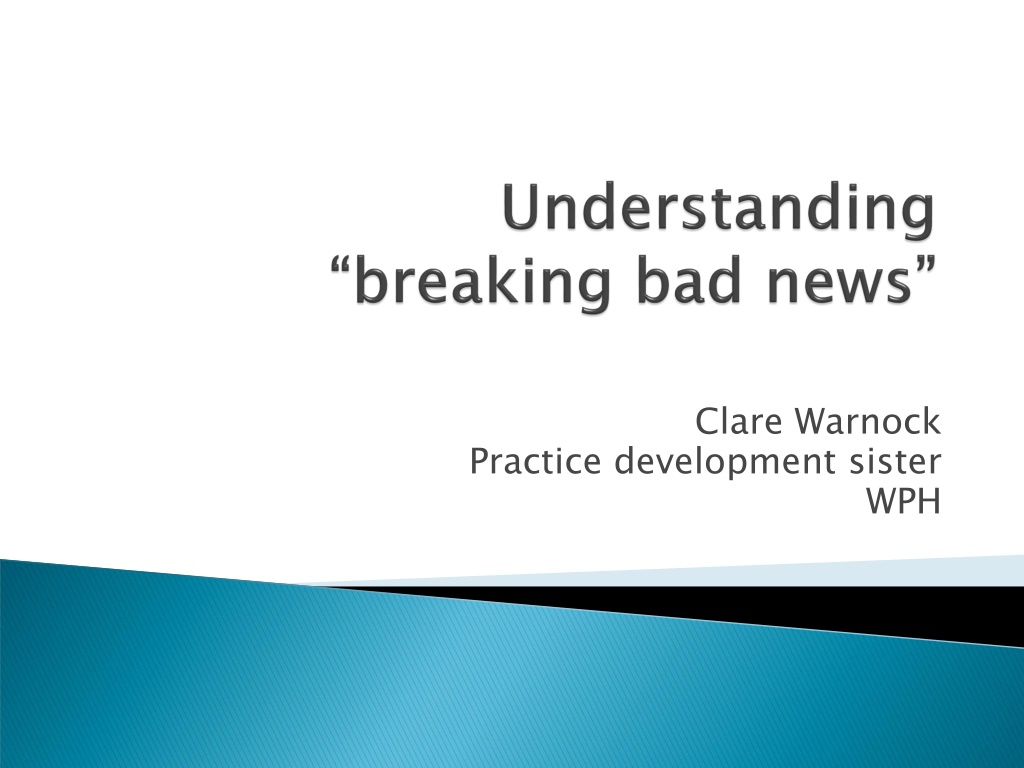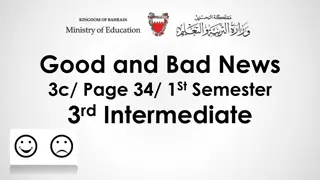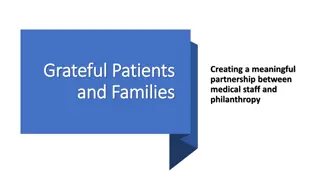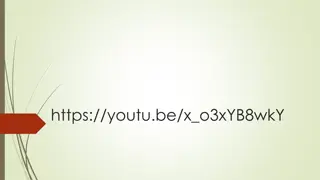Understanding and Communicating Bad News in Healthcare
Exploring the different views on breaking bad news in healthcare, this content discusses traditional and modern approaches, defines bad news, and provides examples of such news. It also delves into how individuals perceive and react to bad news, emphasizing the importance of effective communication in sensitive situations like delivering news about deteriorating conditions or end-of-life care.
Download Presentation

Please find below an Image/Link to download the presentation.
The content on the website is provided AS IS for your information and personal use only. It may not be sold, licensed, or shared on other websites without obtaining consent from the author. Download presentation by click this link. If you encounter any issues during the download, it is possible that the publisher has removed the file from their server.
E N D
Presentation Transcript
Clare Warnock Practice development sister WPH
How would you describe breaking bad news Who does it What is bad news
Traditional view moment doctor diagnosis, prognosis or treatment one to one consultation The HCP acts as witness to what has been said provides support once the consultation is over
Modern view range of HCPs involved information that can be classified as bad news a process multiple episodes of information provision often ad hoc not part of a pre-planned consultation before, during and after bad news is given
any bad, sad or significant information that negatively alters a person s expectation or perception of their present or future (Fallowfield and Jenkins 2004) Key items ANY information Individual expectation Individual perception
Examples informing relatives of deterioration or death, moving into a residential home, explaining the details of arduous treatment providing daily updates when a patient s condition is not improving explaining transitions in care from curative to palliative to end of life failed discharge plans telling someone they can t drive any more
the same information could be interpreted as good, bad or neutral by different people influenced by patient s expectations, values, life experiences and social situation the events leading up to and surrounding the moment that the information is given How might different people react to being told they need to have surgery?
Not about a single consultation This is an important part Dewar s work in spinal injury Initial moment then multiple episodes of potential bad news Realising the implications of spinal injury over time It also involves the activities that take place before, during and after bad news is given
Preparation During After
Assessing needs for further information; recognising their cues and prompts Working with the patient and family to achieve consensus with issues about disclosure Identifying and prioritising the patient s preferences for information Liaising with the healthcare team to initiate discussions where the need is identified or requested Coaching and supporting those who find it difficult to ask questions or talk to the doctors
Helping patients ask questions when they appear to be confused or reluctant to do so Supporting others who are providing the information to find alternative words or explanations if the patient appears not to understand or needs clarification Communicating what has been said in the consultation to the rest of the healthcare team Eliciting patient and relatives feelings about the information they have received
Listening to and acknowledging the emotional reactions of patients and relatives to bad news Explaining and discussing the information received and its implications Answering questions as they arise, identifying and clarifying misunderstanding and explaining complex medical terminology Providing information about the next steps in the care pathway
Supporting decision making about care Explaining complex issues e.g. what is meant by DNAR, informed consent, advanced care directives Support with realising the implications of their situation /the information given Helping the family reach a consensus when there is disagreement between them about the plan of care Acting as an intermediary between patients, relatives and the healthcare team
Patient preference Most patients want to be informed variations in the depth and level of knowledge desired Other potential positive outcomes building a sense of trust between patients and the healthcare team enabling patients and relatives to make appropriate decisions and plans
Treatment and decision making End of life care Family and relative dynamics disclosure issues not tell family, not tell patient Staff in the healthcare team
Confusion over the intention and aim of treatment Having inappropriate and unnecessary treatment False optimism Being unable to marry what is happening with the information received Patients not able to participate in decision making Unnecessary anxiety in worrying about the unknown
Patients and families deprived of essential time before deterioration Preventing the discussion of end of life preferences Patients not having the chance to get their affairs in order
Feeling isolated and unable to communicate with each other Unnecessary strain on family relationships Families carrying the burden of deception
Job stress and burnout Poor job and role satisfaction Disagreement and fractured relationships if not all agree with the information provided
Some patients prefer not to receive some or all of the facts as this is how they cope with their illness Cultural differences In some cultures it can be common for the family to be given the information while the patient is shielded from the full facts. However, individuals are not cultures Patient preferences for information should guide the content, timing and delivery of information
research reveals that providing honest information does not remove hope honest information can support patients in their efforts to maintain hope reduces fear of the unknown enables patients to match their hopes with the reality of their experience Is this a contradiction?
When we worry about destroying hope we often mean a specific hope of getting better or living longer hope is complex, multi-dimensional and flexible The source of hope can change E.g. from hoping for a cure...to hoping to go home reframing of goals to meet the realities at hand Even though it is a reality not wished for
Hopes described by patients with a life-limiting illness include: living longer than expected good symptom management getting the most out of the time that is left making it to certain events achieving certain goals mending damaged relationships spending special time with family and friends This doesn t mean people want to be in that situation (or that they won t be sad/angry/upset) It is a way of coping that can be used over time
Bad news includes many different types of information Information is defined as bad news by individuals cannot always be determined in advance BBN is a process with multiple episodes of information provision as people experience the implications of their situation and raise questions and concerns HCPs carry out a wide range of diverse roles in relation to BBN
The way that significant information is given is important consequences are long-lasting How it is done can influence experiences and satisfaction with treatment relationships with the healthcare team adherence and compliance with treatment coping with the consequences of illness
Providing information in a way that helps the patient understand and cope with what they are told requires skills and knowledge Guidelines and good practice are available These will be explored in the next section of the study day























